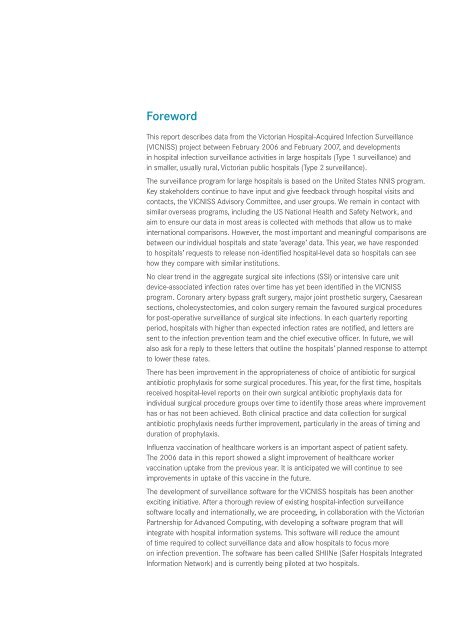VICNISS - Hospital Acquired Infection Project - Department of Health
VICNISS - Hospital Acquired Infection Project - Department of Health
VICNISS - Hospital Acquired Infection Project - Department of Health
Create successful ePaper yourself
Turn your PDF publications into a flip-book with our unique Google optimized e-Paper software.
<strong>VICNISS</strong> <strong>Hospital</strong> <strong>Acquired</strong> <strong>Infection</strong> <strong>Project</strong>: Year 5 report iii<br />
Foreword<br />
This report describes data from the Victorian <strong>Hospital</strong>-<strong>Acquired</strong> <strong>Infection</strong> Surveillance<br />
(<strong>VICNISS</strong>) project between February 2006 and February 2007, and developments<br />
in hospital infection surveillance activities in large hospitals (Type 1 surveillance) and<br />
in smaller, usually rural, Victorian public hospitals (Type 2 surveillance).<br />
The surveillance program for large hospitals is based on the United States NNIS program.<br />
Key stakeholders continue to have input and give feedback through hospital visits and<br />
contacts, the <strong>VICNISS</strong> Advisory Committee, and user groups. We remain in contact with<br />
similar overseas programs, including the US National <strong>Health</strong> and Safety Network, and<br />
aim to ensure our data in most areas is collected with methods that allow us to make<br />
international comparisons. However, the most important and meaningful comparisons are<br />
between our individual hospitals and state ‘average’ data. This year, we have responded<br />
to hospitals’ requests to release non-identified hospital-level data so hospitals can see<br />
how they compare with similar institutions.<br />
No clear trend in the aggregate surgical site infections (SSI) or intensive care unit<br />
device-associated infection rates over time has yet been identified in the <strong>VICNISS</strong><br />
program. Coronary artery bypass graft surgery, major joint prosthetic surgery, Caesarean<br />
sections, cholecystectomies, and colon surgery remain the favoured surgical procedures<br />
for post-operative surveillance <strong>of</strong> surgical site infections. In each quarterly reporting<br />
period, hospitals with higher than expected infection rates are notified, and letters are<br />
sent to the infection prevention team and the chief executive <strong>of</strong>ficer. In future, we will<br />
also ask for a reply to these letters that outline the hospitals’ planned response to attempt<br />
to lower these rates.<br />
There has been improvement in the appropriateness <strong>of</strong> choice <strong>of</strong> antibiotic for surgical<br />
antibiotic prophylaxis for some surgical procedures. This year, for the first time, hospitals<br />
received hospital-level reports on their own surgical antibiotic prophylaxis data for<br />
individual surgical procedure groups over time to identify those areas where improvement<br />
has or has not been achieved. Both clinical practice and data collection for surgical<br />
antibiotic prophylaxis needs further improvement, particularly in the areas <strong>of</strong> timing and<br />
duration <strong>of</strong> prophylaxis.<br />
Influenza vaccination <strong>of</strong> healthcare workers is an important aspect <strong>of</strong> patient safety.<br />
The 2006 data in this report showed a slight improvement <strong>of</strong> healthcare worker<br />
vaccination uptake from the previous year. It is anticipated we will continue to see<br />
improvements in uptake <strong>of</strong> this vaccine in the future.<br />
The development <strong>of</strong> surveillance s<strong>of</strong>tware for the <strong>VICNISS</strong> hospitals has been another<br />
exciting initiative. After a thorough review <strong>of</strong> existing hospital-infection surveillance<br />
s<strong>of</strong>tware locally and internationally, we are proceeding, in collaboration with the Victorian<br />
Partnership for Advanced Computing, with developing a s<strong>of</strong>tware program that will<br />
integrate with hospital information systems. This s<strong>of</strong>tware will reduce the amount<br />
<strong>of</strong> time required to collect surveillance data and allow hospitals to focus more<br />
on infection prevention. The s<strong>of</strong>tware has been called SHIINe (Safer <strong>Hospital</strong>s Integrated<br />
Information Network) and is currently being piloted at two hospitals.

















